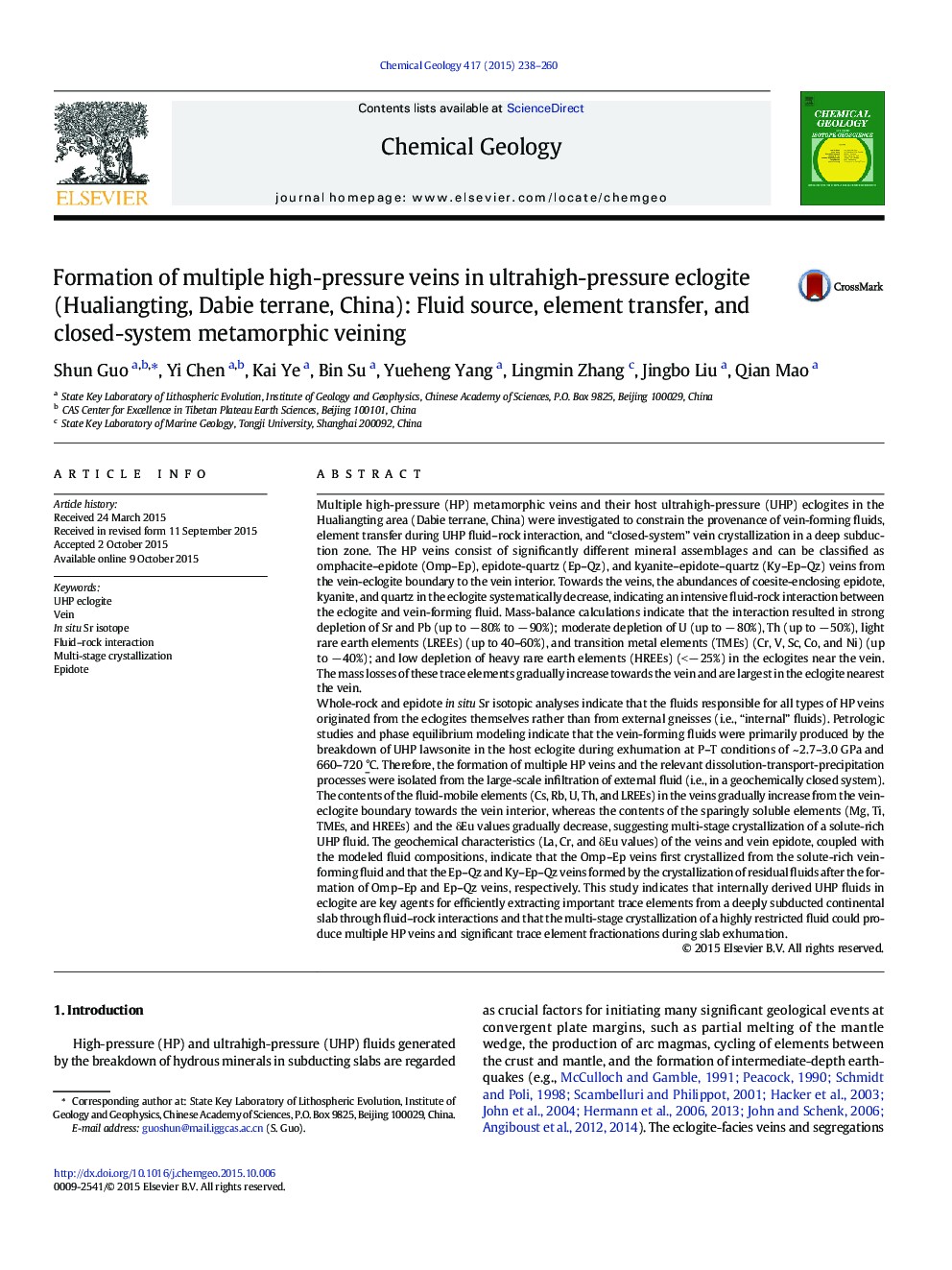| کد مقاله | کد نشریه | سال انتشار | مقاله انگلیسی | نسخه تمام متن |
|---|---|---|---|---|
| 6436270 | 1637557 | 2015 | 23 صفحه PDF | دانلود رایگان |

- Multiple HP veins record complex fluid actions: dehydration, UHP fluid-rock interaction, multiple-stage crystallization.
- Whole-rock and epidote in situ Sr isotope indicate that the fluids responsible for all types of HP veins originated from eclogites.
- The vein-forming fluids were produced by UHP lawsonite breakdown in eclogite during exhumation at 2.7-3.0 GPa and 660-720 °C.
- UHP fluid-rock interaction resulted in mineral dissolutions and significant transfer of various groups of trace elements.
- La, Cr, and δEu of veins and vein epidote provide insights into the crystallization sequence of natural multiple HP veins.
Multiple high-pressure (HP) metamorphic veins and their host ultrahigh-pressure (UHP) eclogites in the Hualiangting area (Dabie terrane, China) were investigated to constrain the provenance of vein-forming fluids, element transfer during UHP fluid-rock interaction, and “closed-system” vein crystallization in a deep subduction zone. The HP veins consist of significantly different mineral assemblages and can be classified as omphacite-epidote (Omp-Ep), epidote-quartz (Ep-Qz), and kyanite-epidote-quartz (Ky-Ep-Qz) veins from the vein-eclogite boundary to the vein interior. Towards the veins, the abundances of coesite-enclosing epidote, kyanite, and quartz in the eclogite systematically decrease, indicating an intensive fluid-rock interaction between the eclogite and vein-forming fluid. Mass-balance calculations indicate that the interaction resulted in strong depletion of Sr and Pb (up to â 80% to â 90%); moderate depletion of U (up to â 80%), Th (up to â 50%), light rare earth elements (LREEs) (up to 40-60%), and transition metal elements (TMEs) (Cr, V, Sc, Co, and Ni) (up to â 40%); and low depletion of heavy rare earth elements (HREEs) (<â 25%) in the eclogites near the vein. The mass losses of these trace elements gradually increase towards the vein and are largest in the eclogite nearest the vein.Whole-rock and epidote in situ Sr isotopic analyses indicate that the fluids responsible for all types of HP veins originated from the eclogites themselves rather than from external gneisses (i.e., “internal” fluids). Petrologic studies and phase equilibrium modeling indicate that the vein-forming fluids were primarily produced by the breakdown of UHP lawsonite in the host eclogite during exhumation at P-T conditions of ~ 2.7-3.0 GPa and 660-720 °C. Therefore, the formation of multiple HP veins and the relevant dissolution-transport-precipitation processes were isolated from the large-scale infiltration of external fluid (i.e., in a geochemically closed system). The contents of the fluid-mobile elements (Cs, Rb, U, Th, and LREEs) in the veins gradually increase from the vein-eclogite boundary towards the vein interior, whereas the contents of the sparingly soluble elements (Mg, Ti, TMEs, and HREEs) and the δEu values gradually decrease, suggesting multi-stage crystallization of a solute-rich UHP fluid. The geochemical characteristics (La, Cr, and δEu values) of the veins and vein epidote, coupled with the modeled fluid compositions, indicate that the Omp-Ep veins first crystallized from the solute-rich vein-forming fluid and that the Ep-Qz and Ky-Ep-Qz veins formed by the crystallization of residual fluids after the formation of Omp-Ep and Ep-Qz veins, respectively. This study indicates that internally derived UHP fluids in eclogite are key agents for efficiently extracting important trace elements from a deeply subducted continental slab through fluid-rock interactions and that the multi-stage crystallization of a highly restricted fluid could produce multiple HP veins and significant trace element fractionations during slab exhumation.
Journal: Chemical Geology - Volume 417, 6 December 2015, Pages 238-260